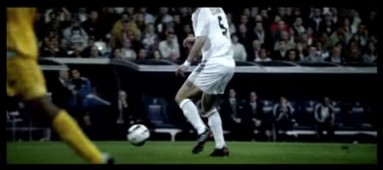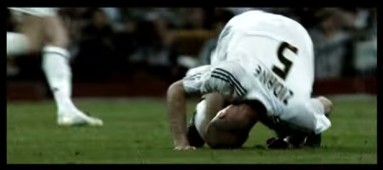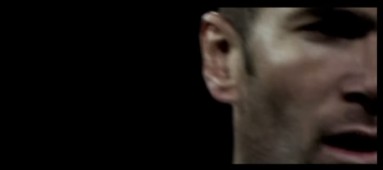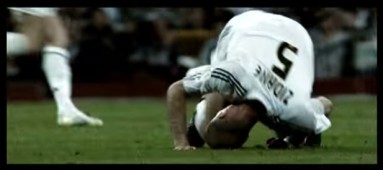


Douglas Gordon's Zidane: A 21st Century Portrait (2006) addresses itself solely to Zidane during a Spanish Liga Real Madrid versus Villareal CF game in April 2005 at the Santiago Bernabéu Stadium. As Gordon tells it, a crew of 150 filmed Zidane in real time using 17 synchronized cameras, each camera equipped with its own operator, focus puller, loader, and runner. The crew for the live event, like Zidane himself, worked without a storyboard. Their only directive came from the Goya portraits Gordon arranged for them to study at the Prado.
Zidane, notoriously private, delivers a testimony of his innermost thoughts in the subtitles. He doesn't "talk" vocally or give a talking-head monologue; the awkwardness of that genre staple is displaced on an elegantly fonted text track. A private life unfolds over a highly public moment. Something between public and private slips through, seductive precisely because it's so out of reach.
The close-up shots aren't so close up as intensely deictic tracking shots. Sometimes focus pulls toward the crowds, with Zidane's figure blurred out. Yet the subject never falls out of view. Zidane is the central compositional element in every shot: every shot rests on him and depends on him.
The main performative gesture of football is ball possession and striking goals. The film muddles this entirely (Zidane seldom possesses the ball, and for a few seconds at best, but the goal is not the goal). By gazing intently at the utter mundaneness of a person at work, the film denaturalizes their labor.
Labor is denaturalized the economy of "real life" too, with college athletes voting to unionize and Muslim players singled out and fined for kneeling on the field in prayer.
But in Gordon's film, the labor of sports performance is laid so bare—or rather, so richly in compositional texture and sensorial minutiae—that its star escapes reduction to political issue or global spectacle. We never forget that we are watching Zidane, yet neither is he the sum-total of his stardom. Man working.
